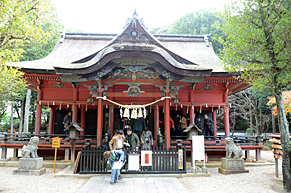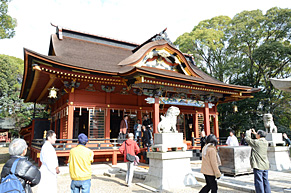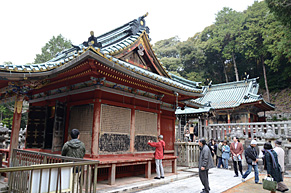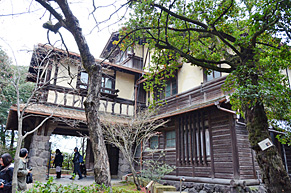

Date and time: December 11, 2010 (Sat) 9:00-17:00
Venue: Nagoya (Rokusho-jinja Shrine, Iga Hachimangu Shrine, Takiyama Toshogu Shrine, Agekiso)
Instructor: Kazuyoshi Fumoto (Professor, Graduate School, Nagoya Institute of Technology)
On December 11, a tour of the architecture of Okazaki and Nagoya was held, "The carpenter ridge of Owari Mikawa and their works." Instructor is Professor Kazuyoshi Fumoto, Professor of Graduate School of Nagoya Institute of Technology. There are 27 participants.
We visited the important cultural property Rokusho Shrine in Okazaki, Iga Hachimangu Shrine, Takiyama Toshogu Shrine, and Yokiso in Nagoya. Okazaki's three architectures were built in the early Edo period by carpenters Yoshihisa Kihara and Choji Suzuki, who were heavily used by Hidetada Tokugawa and Iemitsu.

First, I visited Rokusho Shrine in Okazaki (1636). This building is a complex shrine hall, the so-called Gongen-zukuri, which connects the main shrine and the shrine in votive-offering hall. We visited worship hall, which we usually cannot enter, and the inside of our palace. In this article,main hall,worship hall explained how the difference in the building is expressed by the height of the floor, the luxury of the braids, and the patterns of the animals and plants that are carved.

The next visit was Iga Hachimangu Shrine (1636), an important cultural property. We also visited the inside of worship hall in Gongen-zukuri.
This worship hall is a shrine hall with cypress bark, characterized by the shape of a gable on the roof.
In the previous repair, the color of the outside of the building was restored to its original form and repainted, and the internal coloring with little damage was preserved carefully without repainting. I felt that restoration and preservation were both meaningful.

After lunch, visit Takiyama Toshogu (1646).
The climb and stairs became a good exercise after eating.
This shrine hall, built 10 years after Rokusho Shrine and Iga Hachimangu Shrine, is a separate form of main hall and worship hall.
If you compare the three buildings in this way, you can see the characteristics and changes of the shrine hall configuration.

The last time I visited was Yoki-so in Nagoya. This is a villa of Matsuzakaya founder, Jirozaemon Ito, and was built from the Taisho era to the early Showa era, and was contracted by Takenaka Corporation, which developed from a carpenter ridge from Nagoya to a modern construction industry.
It is now donated to Nagoya City and is open to the public, taking advantage of its historic architecture and gardens.
This time, we specially toured the inside of Choshokaku and Bankaro. It was a wonderful modern architecture that was fruited by the playfulness of the owner and the highest technology of the time.
A very luxurious tour where you can't usually enter the building with an easy-to-understand explanation of Dr. Foot. There was a lot of content, and there was not enough time.
Sometimes it's a good idea to jump out of Kansai and hold tours in other areas.
Customers also said, "I want you to hold a tour outside of Kansai." I would like to be able to hold this exhibition at the same time.
>>Return to the Event



